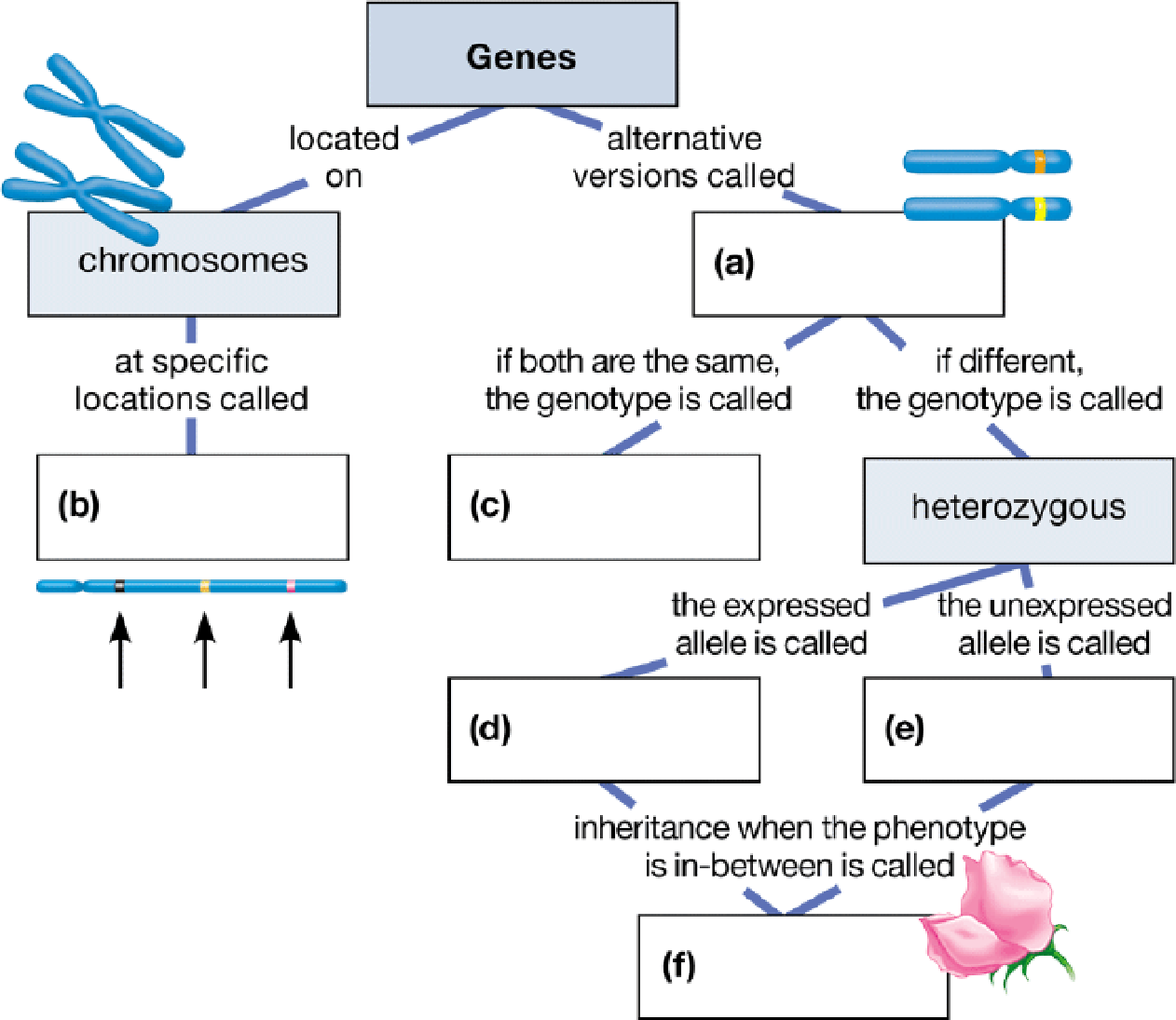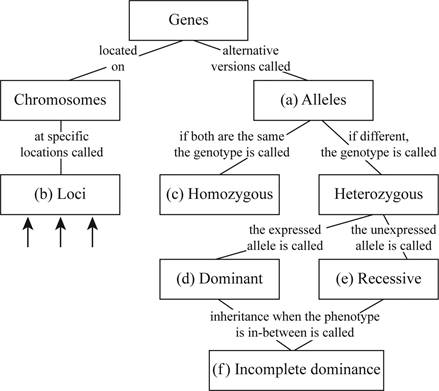
Concept explainers
Connecting the Concepts
1. Complete this concept map to help you review some key concepts of genetics.

To complete: The given map showing some key concepts of genetics.
Introduction: Genetics forms the basis of heredity. It is the study of genes, inheritance patterns, and their expression leading to various traits in living beings.
Answer to Problem 1CC
Pictorial representation: Fig. 1 shows the completed map key concepts of genetics.

Fig.1:Key concepts of genetics
Explanation of Solution
(a)
Correct answer: Alleles
Explanation: Genes have alternate forms known as alleles. The two alleles of a gene segregate into different gametes and are transmitted to offspring. Hence, the correct answer is alleles.
(b)
Correct answer: Loci
Explanation: Genes are DNA sequences that code for specific traits. The specific position of a gene on a chromosome is known as locus. The plural of locus is loci. Hence, the correct answer is loci.
(c)
Correct answer: Homozygous
Explanation: The alleles of a gene segregate into gametes and transmitted to offspring. They are dominant and recessive alleles. When the two alleles are same in an individual(either dominant or recessive), its genotype is homozygous. Hence, the correct answer is homozygous.
(d)
Correct answer: Dominant
Explanation: Dominance in alleles of a gene occurs when a phenotypic effect of one allele suppresses the phenotypic effect of a second allele. If the two alleles are different in an individual, then the dominant allele out of the two alleles expresses itself and determines the phenotype. Hence, the correct answer is dominant.
(e)
Correct answer: Recessive
Explanation: A dominant allele masks the expression of a second allele. The masked allele is known as recessive because its phenotypic effect is suppressed. Hence, the correct answer is recessive.
(f)
Correct answer: Incomplete dominance
Explanation: Dominance explains how different alleles of a gene express themselves. Some genes show incomplete dominance, which means that individuals with homozygous alleles produce offspring that is intermediate of the two parent alleles. Hence, the correct answer is incomplete dominance.
Want to see more full solutions like this?
Chapter 9 Solutions
CAMPBELL BIOLOGY:CONCEPTS+CONNECTIONS
- What is this?arrow_forwardMolecular Biology A-C components of the question are corresponding to attached image labeled 1. D component of the question is corresponding to attached image labeled 2. For a eukaryotic mRNA, the sequences is as follows where AUGrepresents the start codon, the yellow is the Kozak sequence and (XXX) just represents any codonfor an amino acid (no stop codons here). G-cap and polyA tail are not shown A. How long is the peptide produced?B. What is the function (a sentence) of the UAA highlighted in blue?C. If the sequence highlighted in blue were changed from UAA to UAG, how would that affecttranslation? D. (1) The sequence highlighted in yellow above is moved to a new position indicated below. Howwould that affect translation? (2) How long would be the protein produced from this new mRNA? Thank youarrow_forwardMolecular Biology Question Explain why the cell doesn’t need 61 tRNAs (one for each codon). Please help. Thank youarrow_forward
- Molecular Biology You discover a disease causing mutation (indicated by the arrow) that alters splicing of its mRNA. This mutation (a base substitution in the splicing sequence) eliminates a 3’ splice site resulting in the inclusion of the second intron (I2) in the final mRNA. We are going to pretend that this intron is short having only 15 nucleotides (most introns are much longer so this is just to make things simple) with the following sequence shown below in bold. The ( ) indicate the reading frames in the exons; the included intron 2 sequences are in bold. A. Would you expected this change to be harmful? ExplainB. If you were to do gene therapy to fix this problem, briefly explain what type of gene therapy youwould use to correct this. Please help. Thank youarrow_forwardMolecular Biology Question Please help. Thank you Explain what is meant by the term “defective virus.” Explain how a defective virus is able to replicate.arrow_forwardMolecular Biology Explain why changing the codon GGG to GGA should not be harmful. Please help . Thank youarrow_forward
- Stage Percent Time in Hours Interphase .60 14.4 Prophase .20 4.8 Metaphase .10 2.4 Anaphase .06 1.44 Telophase .03 .72 Cytukinesis .01 .24 Can you summarize the results in the chart and explain which phases are faster and why the slower ones are slow?arrow_forwardCan you circle a cell in the different stages of mitosis? 1.prophase 2.metaphase 3.anaphase 4.telophase 5.cytokinesisarrow_forwardWhich microbe does not live part of its lifecycle outside humans? A. Toxoplasma gondii B. Cytomegalovirus C. Francisella tularensis D. Plasmodium falciparum explain your answer thoroughly.arrow_forward
- Select all of the following that the ablation (knockout) or ectopoic expression (gain of function) of Hox can contribute to. Another set of wings in the fruit fly, duplication of fingernails, ectopic ears in mice, excess feathers in duck/quail chimeras, and homeosis of segment 2 to jaw in Hox2a mutantsarrow_forwardSelect all of the following that changes in the MC1R gene can lead to: Changes in spots/stripes in lizards, changes in coat coloration in mice, ectopic ear formation in Siberian hamsters, and red hair in humansarrow_forwardPleiotropic genes are genes that (blank) Cause a swapping of organs/structures, are the result of duplicated sets of chromosomes, never produce protein products, and have more than one purpose/functionarrow_forward
 Human Heredity: Principles and Issues (MindTap Co...BiologyISBN:9781305251052Author:Michael CummingsPublisher:Cengage Learning
Human Heredity: Principles and Issues (MindTap Co...BiologyISBN:9781305251052Author:Michael CummingsPublisher:Cengage Learning Biology: The Unity and Diversity of Life (MindTap...BiologyISBN:9781337408332Author:Cecie Starr, Ralph Taggart, Christine Evers, Lisa StarrPublisher:Cengage Learning
Biology: The Unity and Diversity of Life (MindTap...BiologyISBN:9781337408332Author:Cecie Starr, Ralph Taggart, Christine Evers, Lisa StarrPublisher:Cengage Learning Biology (MindTap Course List)BiologyISBN:9781337392938Author:Eldra Solomon, Charles Martin, Diana W. Martin, Linda R. BergPublisher:Cengage Learning
Biology (MindTap Course List)BiologyISBN:9781337392938Author:Eldra Solomon, Charles Martin, Diana W. Martin, Linda R. BergPublisher:Cengage Learning Biology Today and Tomorrow without Physiology (Mi...BiologyISBN:9781305117396Author:Cecie Starr, Christine Evers, Lisa StarrPublisher:Cengage Learning
Biology Today and Tomorrow without Physiology (Mi...BiologyISBN:9781305117396Author:Cecie Starr, Christine Evers, Lisa StarrPublisher:Cengage Learning





